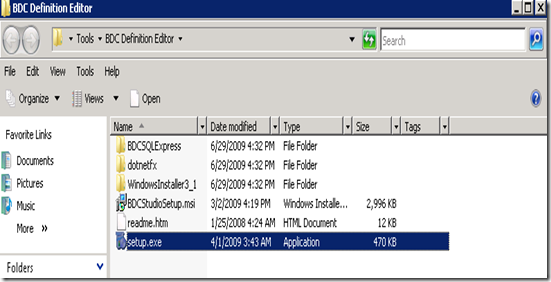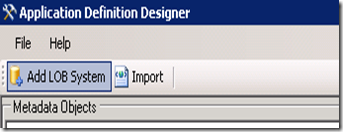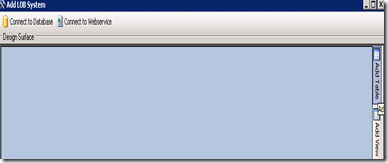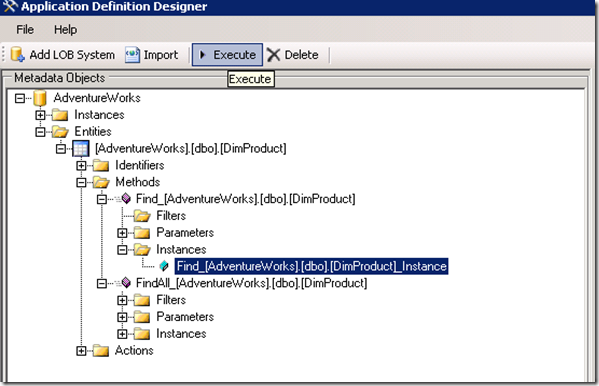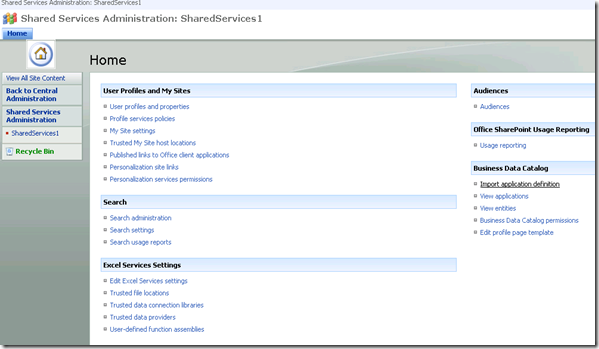Configuring BDC
This blog posting will help in configuring BDC.
Requirement-
SharePoint Server 2007
SharePoint SDK
Adventure Works Database
For backend purpose we will using Sql adventureworks database
1) Install SharePoint SDK-We will be using Application Definition Designer from SharePoint SDK for creating ADF file.
Download details- https://www.microsoft.com/downloads/details.aspx?familyid=6D94E307-67D9-41AC-B2D6-0074D6286FA9&displaylang=en
2) Install AdventureWorks database. Adventure works is SQL sample database provided by Microsoft.
Download details- https://www.codeplex.com/MSFTDBProdSamples
3) Browse to the welcome page of the SDK and click on Business Data Catalog
4) Click on Tools\BDC Definition Editor under Microsoft Data catalog samples and utilities. This will open up a folder which will have a Setup file from installing Application Definition Designer.
Click on the Setup.exe to install Application Definition Designer.
5) Install AdventureWorks Database on your Sql Server.
6) Open Application Definition Designer by clicking Start>Programs
7) Click on Add LOB System
8) Now click on connect to database
9) Here we will need to specify the connection string. For our example we will be using trusted connection but there are different connection strings available.
Replace
myServerAddress with Sql Server Name
myDatabase with AdventureWorks or the database name in case you are using other then AdventureWorks.
After replacing these details click on connect
10) Clicking on connect will take us to the Design Surface. Click on Add Table on the left
11) We can use multiple table but for this example we will be using the table called "DimProduct". To add a table,click on the table and then drag and drop in the right pane. Now click on "OK"
This will prompt you with a screen "Enter the name for the LOB System". Give some meaningful name to your ADF File.
12) Now we will do a quick test to see if our query to the database is returning results or not.
Expand the tree structure based on the screen shot above and select Find_[AdventureWorks] and then click on Execute.
13) This will open up the below screen
Enter a valid value to see if it pulls up the result or not. I picked up the value "1" by looking at the table DimProduct
14) Click on Execute and a valid ProductKey value will pull all the related value.
Now we know that our connection and Find functions are working properly.
15) Now we need to Export our ADF file. Right click on the project name and then save it on your local drive
16) Now we will import the ADF file which we just created. To do this Browse to Central administration page > SSP>Business Data Catalog>Import application defination
17) Give path of the ADF file and then click on Import
On successful import we will get the message "Application definition Import Successful "
18) Now we can see the Entities we created in the ADF File
19) Now to use these BDC column we will create a new Document library
20) Create a BDC Column by browsing to the document library > Settings> Create Column
21) Select the type as "Business data" and then click on "Browse"
22) Select the BDC Application and click on "OK"
23) Once we click on Ok it will populate the list of columns available in the Table.We will select couple of columns to show up

Over here we have selected EnglishDescription,EnglishProductName,ModleName,ProductAlternateKey,ProductKey and ProductLine.
Value under "Display this field of the selected type" is the one against which Check name feature will work
Click on Ok
24) Once we upload a file it will show the BDC Column which we created-
Test- This is our BDC Column.
25) If we look at the File we just uploaded to the document library, we will see the values corresponding to the ProductKey we entered.
All these steps will help us in creating a simple BDC Configuration. We can create and develop more complex BDC solutions using various other tools
Comments
Anonymous
January 01, 2003
I can see all the tables. It is only just as I click ok to confirm and go on to step 12. Any ideas?Anonymous
January 01, 2003
Anyone found a fix for the error "Application Definition Designer has encountered a problem and needs to close"?Anonymous
January 01, 2003
Are you able to see the list of tables from the database? if not then check if you have enoough permissions to connect to the databaseAnonymous
January 01, 2003
Good deatils..It will really help us to configure the BDC in sharepoint.Anonymous
January 01, 2003
Hello! Very detailed article! Thank you! In my blog I posted a few articles about interaction with bdc and external sources programmatically. The articles are SharePoint: Brief introduction to Business Data Catalog (dotnetfollower.com/.../sharepoint-brief-introduction-to-business-data-catalog-bdc), SharePoint: Understanding BusinessData Column (dotnetfollower.com/.../sharepoint-understanding-businessdata-column-bdc-field) and SharePoint: How to get value from BDC (dotnetfollower.com/.../sharepoint-how-to-get-value-from-bdc). Probably, they'll help somebody who still uses SharePoint 2007.Anonymous
January 01, 2003
The comment has been removedAnonymous
January 01, 2003
Hello! Very detailed article! Thank you! In my blog I posted a few articles about interaction with bdc and external sources programmatically. The articles are <a href="dotnetfollower.com/.../">SharePoint: Brief introduction to Business Data Catalog (BDC)</a>, <a href="dotnetfollower.com/.../">SharePoint: Understanding BusinessData Column (BDC Field)</a> and <a href="dotnetfollower.com/.../"> SharePoint: How to get value from BDC</a>. Probably, they'll help somebody who still uses SharePoint 2007.


